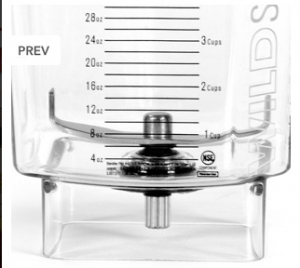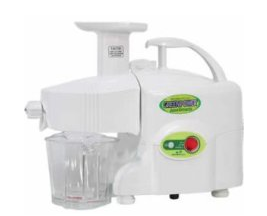Let me say that this was not a scientific controlled venture. And of course – this is my experience and my opinions. If you love a juicer or blender that I didn’t – please don’t take offense. I tested these for recipes/applications that I would use myself and family.
For instance, both blenders make great smoothies – fruit/ice/frozen fruit with add-ins – but for me this is not a compelling reason to own one since I can’t tolerate a lot of sugar/carbs at one sitting. And this is an occasional treat for the rest of the family – usually made with less sweetener than specified in the recipe and with heavy cream.
I had a lot of fun, successes and failures with the juicer/blender testing. I ended up testing these products either through purchase or on loans (thanks Kimberly and Kim!).
- Vita-Mix
- Blendtec
- Omega J8003
- Green Power Twin Gear Juicer
- Jack Lalanne PJP Power Juicer
- Breville BJE510XL Ikon 900-Watt Variable-Speed Juice Extractor
Why Did I Tests All Those Juicers?
I was really curious to see how these appliances would add to my abilities to make nourishing foods. I spend a lot of time preparing foods and testing recipes and I have felt very limited by the ability of my food processor and the immersion blender. They just don’t have that much power – and the food processor is a pain to clean.
I was also intrigued with green juicing – I can’t normally digest raw vegetables that well compared to cooked – and was hoping that juicing might provide a way to get these live nutrients and enzymes in my diet. Another benefit of green juicing – so I was told – is that is cuts carb and sugar cravings – and after taking a little detour from my normal diet – I needed some help returning to what I know works best for me.
Vitamix and Blendtec
These two well-know workhorse blenders are appealing since they are very powerful and can make super smooth hummus, dips, dosa batter, chutneys, salsas, nut butters and more – quickly and clean quicker than a typical food processor.
The Vitamix and Blendtec are blenders – not really juicers since they do not expel any pulp. Upside is that the whole vegetable, fruit, etc stays in the jar. The downside is that the whole vegetable, fruit, etc. stays in the jar. Positive, since you don’t lose/waste any fiber – but I did not enjoy drinking green juices from this – way too pulpy for me. But if you can handle pulp – this is a great option.
Price and warranty are fairly similar. Both are in the $350 to $400 range and offer a long warranty with good customer support (as reported on amazon’s reviews) Horsepower is different – the Blendtec has 3HP on the model that I tried versus the Vitamix’s 2HP. Both jars are BPA free.
Both are very loud! You cannot use these without the whole household hearing and you may want to invest in protective ear gear too – seriously – these machines are really loud. Both are very powerful and can blend the heck out of almost anything. Try watching the “Will it Blend?” videos – very entertaining.
Both come with recipe books that are not that useful for nutrient dense whole food recipes. A lot of substitutions are needed here. Ice cream often calls for flavored coffee creamer or nonfat milk powder and grape juice concentrate. Other recipes call for canned soup or bouillon cubes, and other processed foods that I would never use. I think they are trying to appeal to the more general public taste and convenience. Most of the smoothies and ice cream have a lot of sweeteners.
I did contact both companies to comment and they did send me a few more recipes that were a bit cleaner in ingredients – maybe 30% better. So don’t count on these books as an easy way to get started. You will need to experiment to adapt them to your standards.
Key Differences For Me
The Vitamix has a 4 sided-blade design and a narrow base at the bottom of the jar. So recipes thicker in texture – like hummus, pesto, mayo and ketchup are difficult to get out of the jar. This was very frustrating for me. I tend to make smaller batches of these items – how much pesto can one eat really? And about ¼ or more was wasted since I couldn’t get it out of the jar. Also you have to use the tamper – the big stick thing that you use while the machine is running to keep the food down near the blade. Again – a big drawback for me – more work and I had to stay near the jar while it was blending.
The Blendtec has a two-sided blade design – and it not that sharp – so you won’t cut yourself as you scoop things out. It’s a great design – easy to move it out of the way to get everything out of the jar. And NO TAMPER! I could push the preprogrammed button and stand back while it sucked everything down to the blade. No extra work for me. J
I also found the Blendtec easier to clean as well. But the Vitamix is certainly easier to clean than my food processor.
The Blendtec is also shorter – which makes it fit under most cabinets on the countertop – and this was true for mine. The Vitamix did not fit so I had to store the jar next to the blender – not as space efficient/attractive – but I plan to use this almost daily – so hauling in and out of the cupboard was not an alternative. The Blendtec is 7 pounds versus 10 pounds 9 ounces for the Vitamix – not as easy to travel with or move around the kitchen.
I tested both for several weeks. I returned the Vitamix after 3 weeks – I really didn’t like using this blender. I still have the Blendtec and I don’t think I can part with it.
Onto The Juicers
There are two big dividers in these juicers. The key difference is the way the juice is extracted – centrifugal juicer or masticating juicer. Centrifugal juicers are faster but they are not as efficient at getting the most juice from greens and also other vegetables/fruits in my opinion. The pulp is much wetter than these types versus the masticating juicers. The Omega and the Green Power are both masticating juicers and the Jack Lalanne and Breville are the centrifugal types.

Omega 8000 Juicer – This was by far my favorite. It uses a single auger to extract juice. It is easy to assemble and more importantly easy and fast to clean. So easy that I have been using it daily – often several times a day. The juice is processed at a low rpm speed so less friction and less heat, preserving enzymes that can be destroyed by heat.
Low RPM machines “masticate” or virtually chew the food to squeeze out the juice. High RPM centrifugal juicers spin juice through the air causing exposure of juice to lots of air and thus oxidizing the juice. Low RPM juicers don’t expose the juice to air, reducing oxidation and preserving more of the nutrition in the juice.
It also grinds boneless meat, makes nut butter, raw ice cream (basically feed frozen fruits through the juicer) and extrude pasta with the different nozzles that are included. I have not tried these applications yet.
Green Power Twin Gear Juice Extractor – This is a double auger or a twin-gear triturating juicer. Twin-gear juicers are more expensive and generally harder to clean than a single auger, and I found it much more time-consuming to put together and take apart to clean. I didn’t test this model as thoroughly since the cleaning and figuring out how to put it all back together was more work than I was willing to do. It is also much bigger than the Omega – takes up a lot more space on the counter.
Jack Lalanne PJP Power Juicer Pro Stainless-Steel Electric Juicer – Very fast and loud – not anywhere as loud as the blenders J I found the pulp to be quite wet – so lots of juice wasted.
This is not a great juicer for greens – almost no juice at all. It does better with fruit and carrots. Also it was quite foamy since it is processed so quickly. This juicer is on the lower end cost wise – but it has a reputation of breaking more often than the Omega or Green Power juicers. This was also a pain to clean. Large parts – big footprint on the counter as well.
Breville BJE510XL Ikon 900-Watt Variable-Speed Juice Extractor – I found this a tad better for juicing than the Jack Lalanne. Pulp was wet, juice foamy, not good for greens, clean-up takes a while.
Conclusion
I think testing a juicer or appliance is important so that you can invest wisely in appliances that you will use. Borrowing is a great way to test and most stores have a 30-day return policy. Even two weeks can be a good indicator on how useful a particular machine might be. I hope my post was helpful. What is your favorite?



